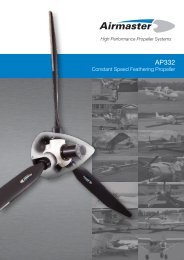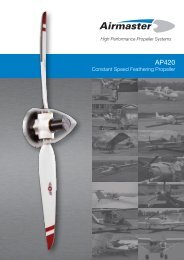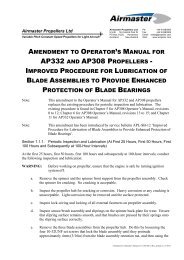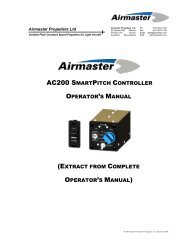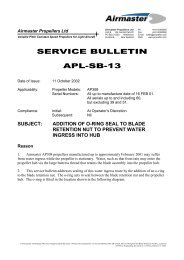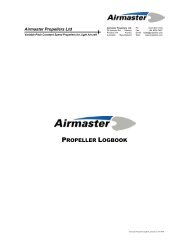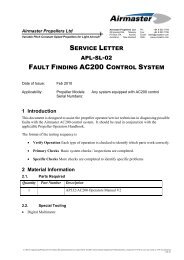APL-SB-11 Sealing of Blade Assemblies.pdf - Airmaster Propellers
APL-SB-11 Sealing of Blade Assemblies.pdf - Airmaster Propellers
APL-SB-11 Sealing of Blade Assemblies.pdf - Airmaster Propellers
Create successful ePaper yourself
Turn your PDF publications into a flip-book with our unique Google optimized e-Paper software.
<strong>Airmaster</strong> <strong>Propellers</strong> Ltd<br />
Variable Pitch Constant Speed <strong>Propellers</strong> for Light Aircraft<br />
<strong>Airmaster</strong> <strong>Propellers</strong> Ltd<br />
Unit B, 144 Central Park Dr<br />
PO Box 21220, Henderson<br />
Auckland, New Zealand<br />
Ph: +64 9 8360065<br />
Fax: +64 9 8360069<br />
Email: sales@propellor.com<br />
Web: www.propellor.com<br />
SERVICE BULLETIN<br />
<strong>APL</strong>-<strong>SB</strong>-<strong>11</strong><br />
Date <strong>of</strong> Issue: <strong>11</strong> October 2002<br />
Applicability: Propeller Models: AP332<br />
Serial Numbers: All up to manufacture date <strong>of</strong> 25 SEP 02.<br />
All serials up to and including 188,<br />
but excluding 160,163 & 183.<br />
Compliance: Initial: At next Periodic Inspection and Lubrication,<br />
or within 25 hours. Whichever is sooner.<br />
Subsequent: Nil.<br />
SUBJECT:<br />
SEALING OF BLADE ASSEMBLIES TO<br />
PREVENT WATER INGRESS INTO HUB<br />
Reason<br />
1. <strong>Airmaster</strong> AP332 propellers may suffer from water ingress while the propeller is stationary.<br />
Water, such as that from rain, is known to be able to enter the blade assembly through the annular<br />
gap between the shank <strong>of</strong> the Warp Drive blade and the ferrule nut. The water then passes down the<br />
two gaps between the blade retention sleeves and enters a cavity enclosed by the blade, the blade<br />
ferrule and the cam-follower attachment spigot. From this cavity water is able to enter the propeller<br />
hub, primarily by passing through the hole for the small spring-pin that retains the cam-follower<br />
stud.<br />
2. This service bulletin addresses sealing <strong>of</strong> this blade cavity and the paths that allow movement<br />
<strong>of</strong> water from the cavity to the propeller hub.<br />
Materials and Parts Required<br />
3. A neutral cure, flexible, non-slumping sealant. Suitable products include RTV silicone rubber<br />
sealants such as Dow Corning 737 neutral cure sealant, Dow Corning 1080 neutral cure sealant, or<br />
Selleys Ro<strong>of</strong> and Gutter Sealant. For ease <strong>of</strong> application it is recommended that this be purchased<br />
in the form <strong>of</strong> a 310g or 10fl.oz. cartridge for use in a sealant gun.<br />
C:\Documents And Settings\<strong>APL</strong> Files\3 Engineering Production\3.3 Product Documentation\3.3.3 Service Bulletins\<strong>APL</strong>-<strong>SB</strong>-<strong>11</strong> & 14\<strong>APL</strong>-<strong>SB</strong>-<strong>11</strong> <strong>Sealing</strong> Of <strong>Blade</strong> <strong>Assemblies</strong>, For AP332.Doc,<br />
created on 27/9/02 by Engineering, last saved on <strong>11</strong>/10/02, printed on <strong>11</strong>/10/02.
<strong>APL</strong>-<strong>SB</strong>-<strong>11</strong> <strong>Sealing</strong> <strong>of</strong> <strong>Blade</strong> <strong>Assemblies</strong> Page 2 <strong>of</strong> 4<br />
Caution:<br />
Do not use an acid cure sealant such as some bathroom sealants (eg Dow Corning<br />
732 multi-purpose sealant). Acid cure sealants produce acetic acid as they cure,<br />
causing corrosion in aluminium.<br />
Action<br />
4. Remove the three blade assemblies from the propeller hub. Do this by loosening the four<br />
10-32UNF set screws that lock the blade assembly until they protrude approximately 4mm (3/16in)<br />
from the blade assembly retention nut, and then using the special blade assembly spanner to loosen<br />
the blade assembly retention nut. Clean dirt and remove excess grease from blade assemblies,<br />
bearings and the blade assembly mounting bores in hub.<br />
5. Ensure that the propeller hub and blade assemblies are dry. If water is present, blow or wipe<br />
<strong>of</strong>f excess water and allow all assemblies to dry in a warm area.<br />
6. Drill a 6mm (1/4in) hole in the centre <strong>of</strong> the inboard face <strong>of</strong> the cam-follower attachment<br />
spigot as indicated in the following diagram. Material thickness at this point is 4mm <strong>of</strong> aluminium<br />
before the drill bit will enter a cavity. Countersink the hole to ensure a smooth edge, as this face <strong>of</strong><br />
the cam-follower attachment spigot is a sliding surface against the plastic pitch change slide.<br />
Figure 1 - <strong>Blade</strong> Assembly showing Required Location <strong>of</strong> Countersunk Hole<br />
Note:<br />
Before injecting sealant, check that the small spring-pin that retains the camfollower<br />
stud (cam-follower stud spring-pin) is in a hole that is drilled right<br />
through the spigot to the cavity within the blade assembly. Check this by poking<br />
a stiff piece <strong>of</strong> wire, such as a straightened paper clip, through the centre <strong>of</strong> the<br />
spring-pin, and seeing whether it is able to reach approximately to the centre <strong>of</strong><br />
the blade assembly. On some examples <strong>of</strong> AP308 propellers this hole may have
<strong>APL</strong>-<strong>SB</strong>-<strong>11</strong> <strong>Sealing</strong> <strong>of</strong> <strong>Blade</strong> <strong>Assemblies</strong> Page 3 <strong>of</strong> 4<br />
been drilled blind. Note whether this hole is drilled through or blind for later<br />
reference when injecting sealant.<br />
7. Support the blade assembly vertically, with the blade tip pointing down. It is recommended<br />
that a bench vice may be used for this, with the blade well protected from the jaws <strong>of</strong> the vice.<br />
8. Push nozzle <strong>of</strong> sealant gun firmlyinto the hole drilled through the face <strong>of</strong> the spigot. Inject<br />
sealant into the cavity behind the spigot as indicated in the diagram below until one <strong>of</strong> the following<br />
is observed:<br />
a. Sealant extrudes through the centre <strong>of</strong> the cam-follower stud spring-pin.<br />
Note:<br />
Sealant will not extrude through this spring pin if its hole is drilled blind.<br />
b. Greater resistance to the injection <strong>of</strong> sealant is felt.<br />
c. Sealant extrudes from one <strong>of</strong> the gaps between the blade retention sleeves within the<br />
ferrule.<br />
Figure 2 - Cross-Section <strong>of</strong> <strong>Blade</strong> Assembly<br />
Showing Hole Drilled through Cam-Follower Attachment Spigot,<br />
and Cavity to be filled with Sealant<br />
9. Approximately 25g (1 fl.oz.) <strong>of</strong> sealant will be required to fill the cavity. The sealant should<br />
completely fill the cavity, blocking the path <strong>of</strong> water through the cam-follower stud spring-pin, the<br />
blade spring-pin, and through the joint between the blade ferrule and the cam-follower attachment<br />
spigot. It is not necessary that sealant also extrude past the butt <strong>of</strong> the Warp Drive blade, into the<br />
area occupied by the blade retention sleeves.<br />
10. Clean any excess and spillage <strong>of</strong> sealant from the face <strong>of</strong> the cam-follower attachment spigot.<br />
<strong>11</strong>. Repeat the above procedure for the remaining two blades.
<strong>APL</strong>-<strong>SB</strong>-<strong>11</strong> <strong>Sealing</strong> <strong>of</strong> <strong>Blade</strong> <strong>Assemblies</strong> Page 4 <strong>of</strong> 4<br />
12. Allow the sealant to cure over at least two days before reassembling propeller.<br />
13. Conduct Periodic Inspection and Lubrication in accordance with operator’s manual (Chapter<br />
<strong>11</strong>). Ensure that each blade assembly is free from moisture and well lubricated. Ensure that the<br />
propeller hub is free from moisture and well lubricated.<br />
Note:<br />
Refer to the improved Periodic Inspection and Lubrication procedure issued as an<br />
amendment to the operator’s manual by service bulletin <strong>APL</strong>-<strong>SB</strong>-12<br />
14. Reassemble each blade assembly into the propeller hub in accordance with the instructions in<br />
the operator’s manual (Chapter 5).<br />
Recording<br />
15. Record completion <strong>of</strong> service bulletin <strong>APL</strong>-<strong>SB</strong>-<strong>11</strong> in propeller logbook.



